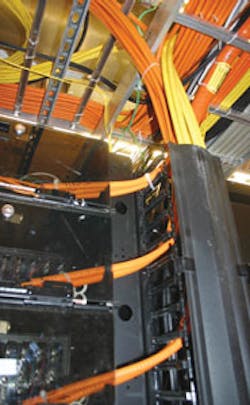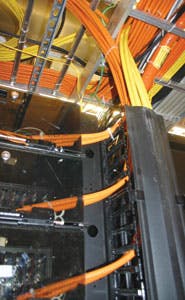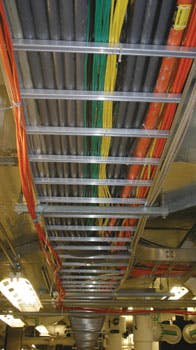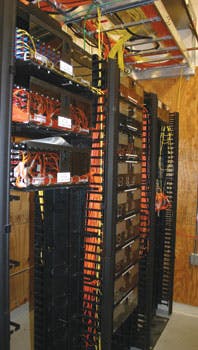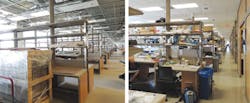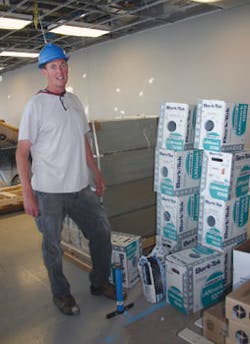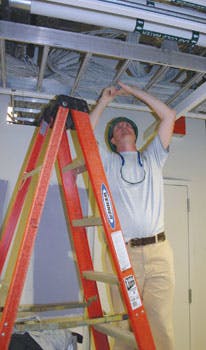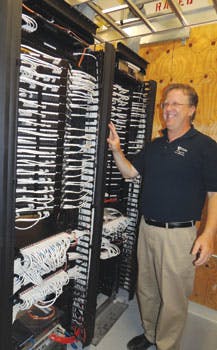Modular cabling for IP convergence in advanced medical research center
From the October 2012 Issue of Cabling Installation & Maintenance Magazine
The Translational Research Center, a joint venture between the University of Pennsylvania and the Hospital of the University of Pennsylvania, has unique and demanding requirements of its network infrastructure.
By Carol Everett Oliver, RCDD, ESS; Berk-Tek, a Nexans company
When an information technology (IT) manager in the healthcare industry is tasked with designing a network, the assignment includes many unique cabling challenges-the breadth of Internet Protocol (IP) applications, the atypical installation environments and the pathways of the cable runs, the increasing bandwidth of digital-imaging files and, of course, selecting the cable that will reliably handle today's and tomorrow's needs. Take all this and multiply these challenges by two when designing a combined medical-research facility for a university and hospital.
The new $261-million, 500,000-square-foot Translational Research Center facility in Philadelphia is the first joint venture between the University of Pennsylvania (Penn) and the Hospital of the University of Pennsylvania (HUP). They are two separate entities, yet joined "at the hip" when it comes to medical research.
"Although the hospital is part of the overall university, the two operations are separate when it comes to the IT and facilities management," explains Tom McCaffery, network project manager.
The Translational Research Center was originally planned five years ago as a new building solely for the university's medical school, but that quickly changed when it was realized that medical research for both the hospital and university could be combined into one complex. As a result, this facility houses research labs for the medical school and the university research to integrate biomedical disciplines needed to advance the medical field in the understanding of diseases and to develop new therapies.
In addition, because of the building's close proximity to Penn Medicine's patient-care facilities in the adjoining Perelman Center for Advanced Medicine, the Translational Research Center is a local and global communications center between clinicians and researchers. It's one building but with countless vital health-research purposes.
The 12-story facility has three floors of clinical research labs for the hospital and six floors of dedicated research areas for the university. In addition there are common areas including media area, conference rooms, cafeteria, an auditorium and lobby. Each unique area created its own cabling challenge in regards to installation environment. Planning the infrastructure was a combined effort by both IT operations; however, McCaffery took the lead for the design of the cabling infrastructure. Applications running over the network include data, voice, wireless access points, security cameras, access control, clocks, video and AV.
"Although the entire building consists of two networks with separate electronic equipment, such as switches, we specified the same cabling infrastructure but kept them separate either physically or on VLANs [virtual local area networks]," McCaffery explains. "We wanted a totally modular infrastructure-one cable type for all applications so that any wire could run any application by simply re-patching in the telecom rooms. This is the first time that we accomplished a true IP convergence scenario between Penn and UPHS."
From the ground up
At the very beginning of the design phase, both sets of IT teams, from the university and from the hospital, met to discuss how to converge the network design-making it consistent in design, yet separate in operation. Penn's network is based on "port recovery," which means they charge their users by the ports used through their PennNet network service-including cabled and wireless services. "We basically provide 100 Mbits/sec to the desktop, unless they need more bandwidth, and then it's one gigabit to the user," explains McCaffery. The UPHS network, called UPH Net, is kept separate to support HIPAA privacy regulations. Therefore, only through the secure UPH Net can patient records be accessed, while student and library records are accessed on PennNet. "It can get confusing," McCaffery says, "so you can see why it made scoping out this installation so challenging."
The good news is that during the design phase of this facility, McCaffery's plan, which included ample cores for the risers as well as spacious equipment rooms, was accepted. "When you are dealing with a blank canvas, it is easy from the beginning to provide detailed layouts and explanations as often there is not enough room for the cabling pathways-backbone and horizontal-or large enough telecom rooms," he notes.
The demarcation point for the outside plant is usually determined by the service provider. At this location the fiber-optic outside-plant cable that connects this facility to the entire hospital and university campus is located in the adjoining Ruth and Raymond Perelman Center for Advanced Medicine. It was decided that the Penn demarcation for the main equipment room for the backbone and horizontal cabling would best be suited on the fifth floor. This way the risers would be split; half would service the upper floors and half would service the floors beneath. "If you put the equipment in the basement, then you end up with real long runs; and for me, this way just made common sense," McCaffery says.
Penn has a total of 24 telecom rooms and HUP has six. The riser cable is a combination of cabling types. For the backbone cable for data and most of the IP applications, LANconnect Inc. of Norristown, PA, the cabling contractor, installed 8,500 feet of Berk-Tek's ArmorTek optical fiber cable with GIGAlite-10 Om3 50-micron fiber. LANconnect installed 24 strands of singlemode fiber and 12 strands of multimode fiber in redundant pathways to each telecom room. Berk-Tek's flexible armoring provides extra protection of the cable, while eliminating innerduct, allowing more cables in less pathway space and also adding to a more-cost-effective and quicker installation.
The Penn network runs Voice over IP phones, but HUP does not. Therefore, Berk-Tek 200-pair Category 3 cables were terminated in the main equipment room on the fifth floor for the traditional phones. From there, Berk-Tek 100-pair Category 3 plenum cables run to each of the HUP TRs and are punched down onto 66 blocks on the wall. Penn also tapped off the copper backbone and pulled Berk-Tek 50-pair Category 3 plenum backbone cable to each of its TRs, and interconnects them to the patch panels on an as-needed basis for faxes and emergency lines.
In addition, although they broadcast through fiber feeds, local video distribution is over coaxial cabling for Penn Video Network, so 8,500 feet of coaxial cable were pulled.
Total IP modularity
All the horizontal cabling from the TR to the desktop locations is consistent for both networks. In total, LANconnect pulled almost 2 million feet of Berk-Tek's LANmark-1000 enhanced Category 6 cable, which was hard-speced by Tom McCaffery.
"Because of the immense amount of copper cable needed for this job and our requirements to have the cable delivered on an as-needed basis due to a long installation period-almost three years-we were able to negotiate a set price between Berk-Tek and the local distributor, Graybar," McCaffery explains.
"We knew that there was a possibility of inflated pricing, due to the fluctuation of copper prices, which is the single hardest item to project the cost," he adds. "In the long run, this saved us countless dollars and also made the installation run smoother as Graybar stocked the cable for us at a local warehouse."
The Berk-Tek cabling for all of the low-voltage applications is terminated to Siemon HD 6 angled patch panels, which allow easy cable manageability. The cable is color-coded-green for the HUP cable for the clinical applications, red for security and gray for all of PennNet. "'One cable for any application' is our mantra for total modularity," McCaffery says. "This means that any cable can connect to any service-whether it is for data, phone, building control, clocks or wireless-since they are connected to Ethernet ports. The application designation happens in the TR between the patch panel to the associated active equipment," he continues. "Therefore all the changes happen by simply reconnecting patch cords in the TR, which eliminates separate horizontal runs for separate applications-structured cable simplicity at its best."
Although some of the applications, such as security, run on VLANs, all run through the same network, which can be switched easily in the TRs.
Unique workstations
The workstation areas are diverse, depending on the location. Most of the Penn floors were divided with labs on one side of the building, and conference rooms and research offices on the other side, overlooking Center City Philadelphia. There are approximately 1,500 horizontal cable runs per floor, which total about 250,000 feet of Berk-Tek LANmark-1000 per floor. The work areas include floor boxes in offices and conference rooms and on bollard posts in the labs. Of course, there are facility outlets above the ceiling for wireless, and in the ceiling and on walls specified for security cameras, access control and digital clocks. Cables to the offices and conference rooms are fed from cables running in the ceiling space from the floor below and terminated to floor boxes. This eliminates communications columns to create a visually open area.
Because of Penn's port recovery system, a prior port utilization study was conducted to find out how many cables are required to be pulled to each outlet. In years past, Penn's standard was three cables to each location, but through the study they found out that there was 96 percent usage of the first port, 45 percent of the second port, 16 percent of the third, and if there was a fourth it was not used at all.
In this project, three cables were pulled to each workstation outlet with the exception of the labs in which two cables were designated for each workstation, which total 16 total cables per lab bench.
"Terminating to the lab benches was a challenge to the installers as the cable had to be fished through the pathway above the lab desk and punched down on the bollard post from the backside and then snapped back into place," explains Tom McDonald, the foreman for LANconnect. "After two years with more than 20,000 man-hours on the job site, we were happy to report not one failure when we tested the cable runs."
LANconnect employees are certified installers and by providing documented test results obtained by using the Fluke Networks DTX-1800 Cable Analyzer, the Berk-Tek/Siemon cabling system-products and installation-is guaranteed for 20 years' performance above the Category 6 standards through Siemon's System 6 warranty program.
Scalable consistency
Today Penn's cable standard to the desktop is specified as Category 6. In some areas Category 5e is used for moves, adds and changes (MAC work) from older infrastructures that still exist on campus.
"We are looking at Category 6A for futureproofing and being able to handle larger bandwidth files, such as forecasted in our next research building," McCaffery explains. "This will make more sense once 10-Gig Ethernet active equipment is easily attainable and the technology more widely adopted." Because Penn updates its active electronic equipment in accordance with a predetermined replacement schedule, the university can match the cable to suit the electronics' recommended requirements.
"One thing I've learned in my 17 years with Penn's Information Systems and Computing organization is that when you make a change to the IT infrastructure, it's got to be scalable," McCaffery observes. "So when we update our existing 250-plus building campus specifications to a higher level of cable, it will become the standard until the newer technology eventually replaces it. For now, our infrastructure is solid and our modular layout allows for easy upgrades to take place in the TR."
Carol Everett Oliver, RCDD, ESS is marketing analyst at Berk-Tek, a Nexans company (www.berktek.com); she also is Northeast Region Director for BICSI (www.bicsi.org). She has authored numerous articles for Cabling Installation & Maintenance magazine and is a frequent presenter at industry events covering cabling infrastructure planning and best practices. She can be reached at [email protected].
